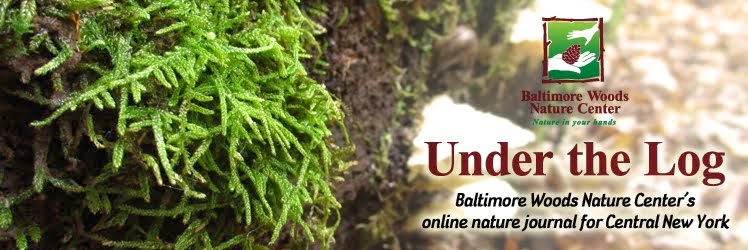This is a story of how a few organizations -
- and many, many children - - turned an old farm into a nature preserve,
created a permanent home for nature education, and spurred a nature
conservation movement and a partnership that is still going strong over forty
years later.
On a cold and snowy Saturday morning in late April
of 1972, over 3,000 people, most of whom were elementary school students, started out on a fifteen mile
‘walkathon’ that was organized to raise money to protect natural areas in
Onondaga County, and one piece of land in particular.
A few years earlier, several local nature and
environmental groups had started discussing the need to protect the vital
natural areas in Onondaga County, and they formed a coalition to tackle the
problem. The one unprotected natural area that was at the top of everyone's
list was a tract of mostly abandoned farmland in the Town of Marcellus.
The weedy overgrown fields, the scrubland, and the
small pockets of old growth woods had become known as one of the best places to
go to watch birds and find wildflowers. People learned that the old farm would
soon be put up for sale, and was already being scrutinized as site for an open
pit sand and gravel mine.
The coalition of nature and environmental groups
approached the town (Marcellus), the County, and then the State to try to
persuade them to protect the property as a natural area. However, they were
turned down at every step. Eventually, the coalition convinced The Nature
Conservancy to agree to buy the property before it could be clear cut and
turned in to an open pit mine. Unfortunately, The Nature Conservancy did not
want to own or maintain the property, and they also stated that they needed to
be paid back.

The coalition then formed a separate organization,
called Save the County (STC), to handle the necessary fundraising to pay for
the Marcellus property as well as other natural areas in need of protection.
STC hit upon the idea of a walkathon that would enlist schoolchildren and other
concerned people to get monetary pledges for each mile walked. That was the
origin of the snowy walk in April of 1972, and it was a great success, in terms
of both participation and fundraising. The first Walk to Save the County raised
over $24,000, and two months later, the purchase of the first 99 acres of the
parcel was complete. The land purchased was the core of what would later become
known as Baltimore Woods Nature Preserve.

The Walk to Save the County became an annual event
and grew even more successful, raising more than twice as much money the
following year. Save the County was then able to reimburse The Nature
Conservancy and began looking for someone to take over the ownership of the
property. Once again, the Town, County, and State all declined to take
ownership of it, so Save the County incorporated and expanded its mission to
own land as well as to fundraise for the protection of natural areas.
A few years later (1975), Save the County paid for
the purchase of a 24 acre addition to Baltimore Woods. At around this time, one
of the original coalition member organizations, Onondaga Nature Centers (ONC),
was starting to look for looking for a new home. ONC (founded in 1966) had been
running the nature center at Beaver Lake County Park, but the county was ready
to take over the operation at Beaver Lake, and Baltimore Woods was the natural
place for ONC to move.
In 1976, Bicentennial fever swept the land, and ONC
drew up plans to turn Baltimore Woods into a Historic Land Use Center that ONC
would run. The Historic Land Use Center was going to feature living history
with an Indian village, a pioneer homestead, pioneer village and an 1870s
farmstead. That same year STC
finished paying back The Nature Conservancy.
In 1977, The Nature Conservancy transferred the
property to STC with the stipulation that the property would be used as a
nature education center and ONC began to host regular educational programs
there as well as taking over the stewardship for the property.
In 1978 development of the property had begun, the
first trails were added, an old farm house was moved to the property to serve
as the headquarters for ONC and construction began on the pioneer cabin,
unfortunately interest in historic reenactment rapidly waned and the pioneer
cabin was the only part of the historic land use plan to be realized.
The coming years more land would be added to the
nature preserve in 1979, 1982, 1994 with a final addition in 2002 that brought
Baltimore Woods to its present size of 179 acres.
Over time, both Onondaga Nature Centers and Save
the County grew and evolved, ONC eventually changed its name to Baltimore Woods
Nature Center because it had become so synonymous with the nature preserve.
Save the County transitioned its mission from
fundraising for conservation to direct land protection and changed to Central
New York Land Trust (CNYLT). From that first 99 acres CNYLT has gone on to
protect over 2,800 acres on 49 nature preserves.
The partnership between the Nature Center and the
Land Trust is still going strong today with the ownership of The Woods split
between the two, the Nature Center owns the land around the Interpretive Center
and the Land Trust owns the majority of the Woods.
As the proverb goes, “Mighty oaks from little
acorns grow”.
Blog post by Jeff Devine





















